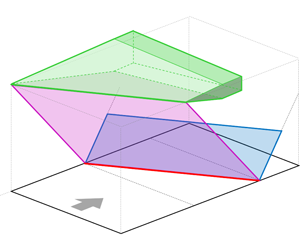Article contents
An inviscid analysis of swept oblique shock reflections
Published online by Cambridge University Press: 17 March 2020
Abstract

An inviscid flow model is presented to gain a basic understanding of the reflection of a swept oblique shock from a planar wall. The analytical model is constructed to describe the fundamental influence of sweep on this shock configuration, which has been commonly studied as an unswept non-dimensional shock boundary layer interaction (SBLI). Transformation of model parameters into a plane perpendicular to the sweep angle reduces the resultant flow to a two-parameter system. An equivalency between this configuration and others commonly assessed is presented with advisory notes on the definition of effective coordinate systems. Inviscid shock detachment has been associated with the onset of quasi-conical SBLI spanwise development; see (Settles & Teng, AIAA J., vol. 22 (2), 1984, pp. 194–200). Its occurrence for this SBLI configuration is determined for a range of conditions and compared to experimental observations of swept SBLIs claiming cylindrical/conical similarity scalings. Finally, influence of a zero-mass flux plane associated with typical experimental and numerical analyses is presented with an accompanying model for the shock structure. While this paper serves as a useful resource when designing swept impinging oblique SBLI studies, it also provides a vital benchmark for this complex configuration and helps to unify various SBLI configurations that are often analysed in isolation.
JFM classification
- Type
- JFM Papers
- Information
- Copyright
- © The Author(s), 2020. Published by Cambridge University Press
References
- 17
- Cited by


